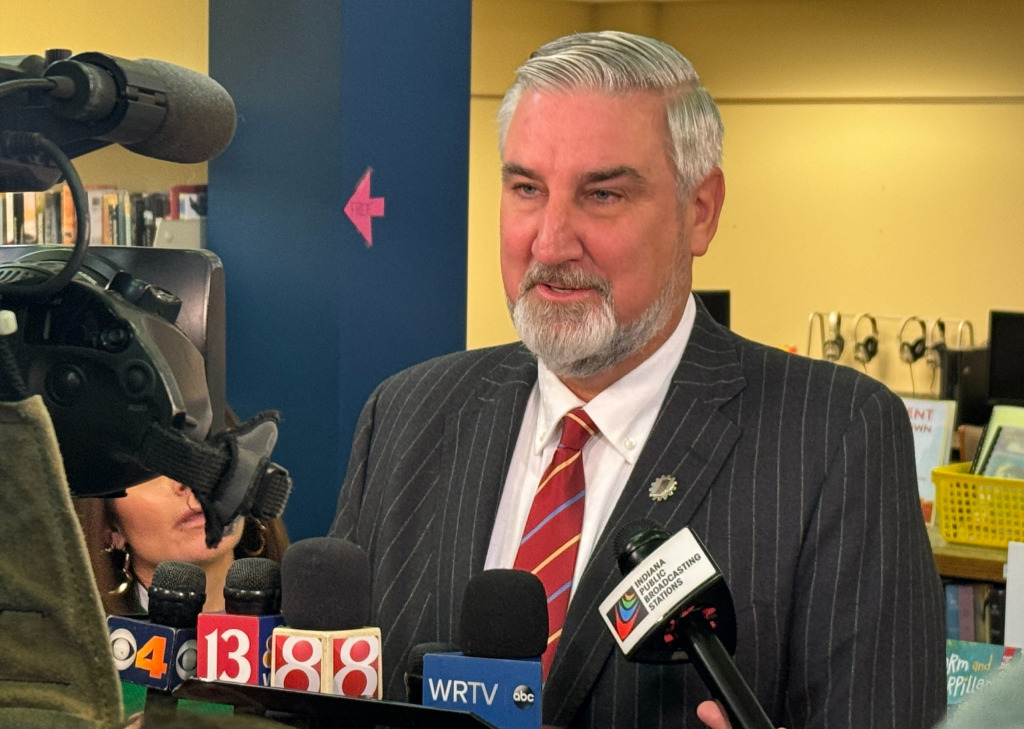Subscriber Benefit
As a subscriber you can listen to articles at work, in the car, or while you work out. Subscribe NowGov. Eric Holcomb on Monday unveiled the eighth and final legislative agenda of his two-term tenure, focusing on improving the state’s child care system, addressing falling early literacy levels and raising awareness of the state’s myriad of job-related training programs and tools.
The proposals, which include everything from holding back third graders who can’t read to lowering credential requirements for child care workers, aim to solve the state’s workforce development challenge by preparing students for success after graduation and helping employers find skilled workers.
The governor presented his 2024 Next Level Agenda, which includes legislative and administrative priorities, at the Indiana School for the Deaf and Blind, which received significant state funding for capital improvements in the 2023-2025 budget.
The unveiling comes as Indiana lawmakers return to the Statehouse this week for the 2024 legislative session.
To showcase state investments made in public health, child care, education and workforce in the biennial budget passed in the 2023 session, the governor’s office announced the creation of the “Hoosier playbook,” described as “a place-making resource guide for local leaders and partners” to strengthen their communities.
To address falling reading levels, the governor unveiled a proposal to require schools to administer IREAD in second grade and to offer summer school reading programs to students in second grade who are not on track for reading proficiency and third graders who did not pass.
The proposal would also require third grade students who do not pass the reading proficiency exam to be held back a year starting in the 2025-2026 school year, a controversial measure that has faced criticism from some education advocates.
Holcomb also aims to establish a computer science requirement for high school graduation beginning in 2029, an idea that has support from the state’s top employers.
The governor’s office also announced the launch of a statewide workforce development campaign, “One Stop to Start,” with the goal of connecting Hoosiers with existing workforce- and job-related training programs and resources. The initiative will use funds from the Governor’s Workforce Cabinet to promote awareness and access to Indiana’s NextLevel Jobs Programs.
The campaign’s website includes an online navigation system for Hoosiers and employers and offers one-on-one assistance for both Hoosiers and employers through a team of dedicated navigators.
“The overall goal of ‘One Stop to Start’ is making sure Hoosiers have awareness of and access to the programs that can get them on that path to realizing a high-wage career,” Holcomb said in written remarks. “There’s a pathway for all Hoosiers, and ‘One Stop to Start’ will help individuals discover various operations that fit their needs.”
The campaign’s website highlights emerging and in-demand industries such as microelectronics and semiconductors, electric vehicles, advanced manufacturing and alternative energy production, while also emphasizing the importance of critical job needs in health care, education, public safety and skilled trades.
The program is led by the Governor’s Workforce Cabinet and the Indiana Economic Development Corp., in partnership with the Indiana Department of Workforce Development, the Indiana Commission for Higher Education, the Indiana Department of Corrections, IN Vets and the Family and Social Services Administration.
Other measures in the governor’s agenda include creating a task force to review bail reform efforts and their impact on violent crime and recidivism rates; directing social service agencies to focus on the state’s aging population and the complex mental and behavioral health challenges facing Hoosier youth; and working with legislators to make it easier for communities to prepare for and recover from natural disasters.
Please enable JavaScript to view this content.

